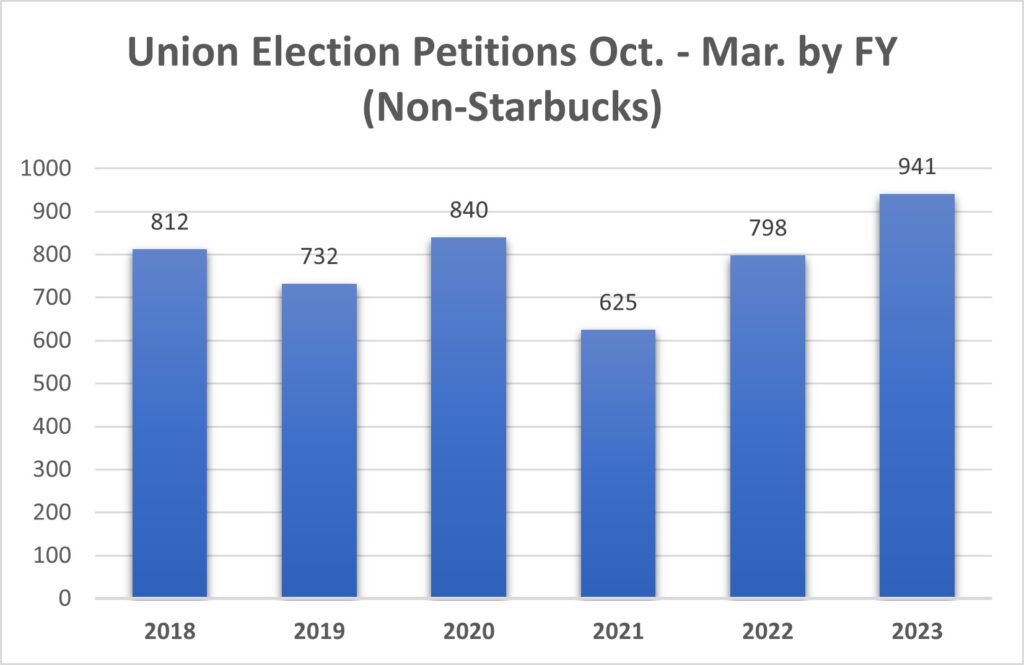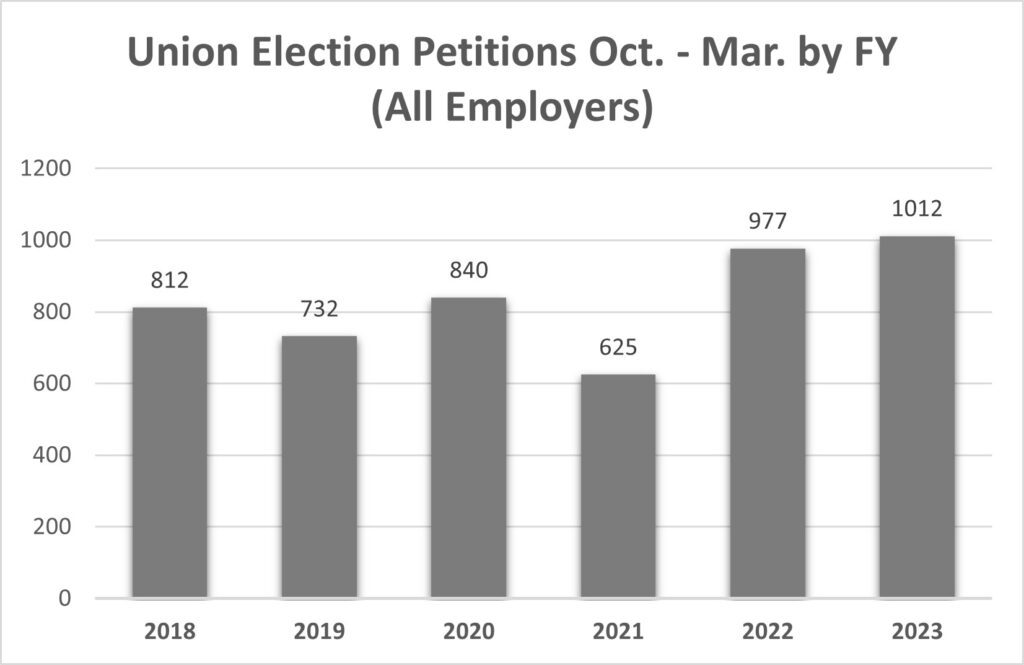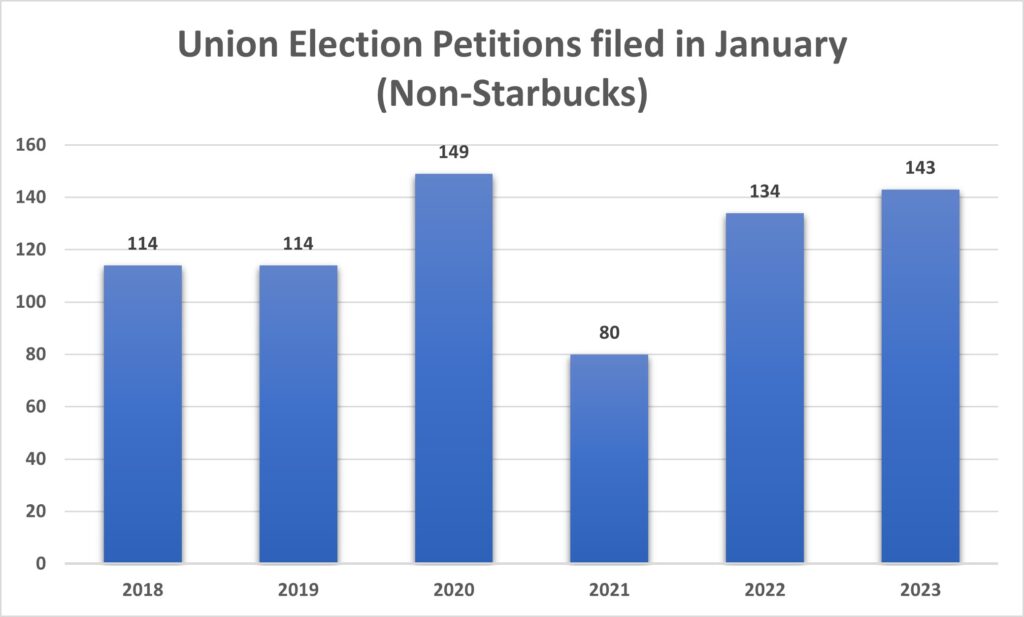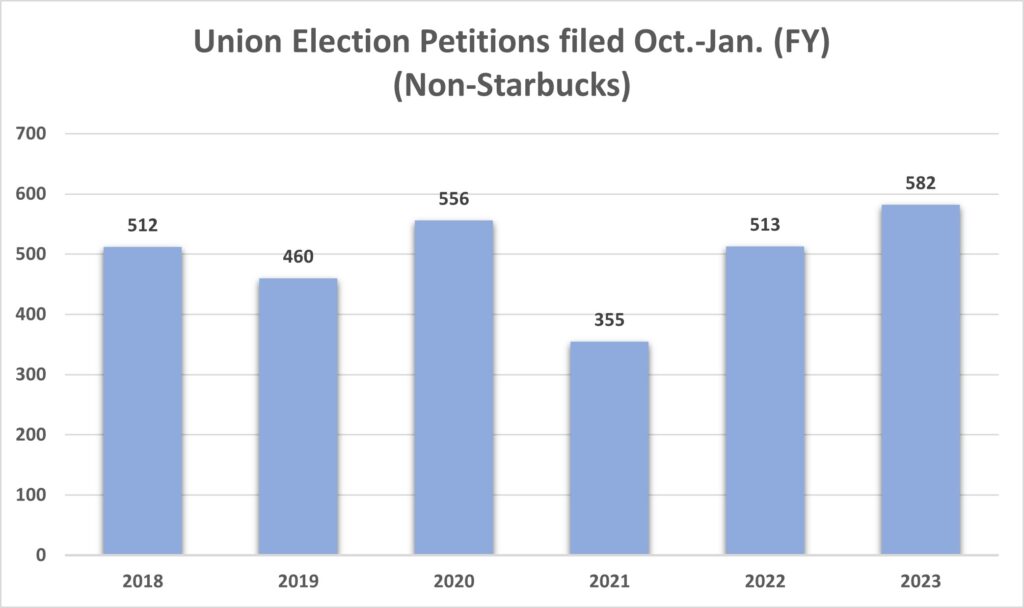In an April 7, 2023, press release, the National Labor Relations Board announced a slight increase in union election petitions for the first six months of its 2023 fiscal year. Digging deeper, however, the latest data may suggest more of an uptick in unionization than even the NLRB acknowledges. After stripping away the unprecedented number of Starbucks elections sought last year, the number of union election requests from October 2022 through March 2023 reveals a potentially much broader trend.
NLRB Press Releases
The NLRB’s recent press release focused more on unfair labor practice charge filings, which were up 16% during the first half of the current fiscal year. Unlike last year’s corresponding release, the reference to union election petitions was much more subdued. October – March FY ’23 saw 1,200 total representation cases filed, compared to 1,174 during the same period last year. That’s only a 2% increase.
In the first half of FY ’22, the NLRB reported a shocking 57% increase in representation case filings. As we discussed at the time, that statistic was skewed by two key factors: Starbucks and COVID-19. The NLRB’s numbers also aggregate all representation cases, not just those seeking to form a union in the first instance. Most notably, “representation cases” also include filings seeking to remove a union from a workplace. Such “decertification” filings were up 35% in the first half of FY ’22 compared to the corresponding months in FY ’21. (These “RD” cases are back down 13% in FY ’23.)
In some senses, it’s fair to say the NLRB oversold the increase in representation cases a year ago. Yes, it was dealing with more cases than in the previous year. But, Starbucks aside, that didn’t reflect an overall greater propensity to organize. Nonetheless, we may now be experiencing that reality.
Union Election Requests – RC Petitions
Overall, the National Labor Relations Board received 1,012 “RC” petitions seeking union representation between October 2022 and March 2023. That’s a 3.5% increase over the 977 petitions from the same period last year.
But, when you simply remove the Starbucks cases, the magnitude of the increase rises to 18%. The 941 non-Starbucks cases so far in FY ’23 exceed the total (840) for the first six months of FY ’20, which ended just as COVID-19 started to shut down the U.S. By contrast, the 798 non-Starbucks cases for the same period last year (FY ’22) did not. In other words, non-Starbucks RC cases in Oct.-Mar. FY ’22 were down 5% compared to the last corresponding pre-COVID period, but the Oct.-Mar. FY ’23 filings were up 12%.
Starbucks RC Petitions
With 354 union election petitions involving Starbucks in FY ’22, it’s no surprise RC filings for the coffee retailer are down in the first half of FY ’23. There are fewer stores left to unionize. And the rare few that voted against the union are not yet susceptible to a new petition due to the NLRB’s “election bar” rule. Nonetheless, there still were 71 union election requests filed involving Starbucks between October 2022 and March 2023.
The following graph shows the total number of RC petitions filed in the first half of the corresponding NLRB fiscal years since FY 2018.
State-Specific Data
Looking at the data more locally, on a state-by-state basis, we see a few trends that may be instructive despite the relatively smaller sample sizes. As usual, California and New York have experienced the most union election requests in the first half of FY ’23. New Jersey and Pennsylvania have experienced a notable decline, while filings are up in Alabama, D.C., Massachusetts, North Carolina, Oregon, and Texas.
For this analysis, we’re excluding RC filings at Starbucks stores. As part of a nationwide employer-specific movement, we assume they’re less instructive of the general union activity in a particular geographic region. All statistics below are for the first half of the fiscal year (October through March) mentioned.
Alabama
Alabama sees very little union activity compared to most states. But the 8 union representation petitions filed so far in FY ’23 are double what the state usually sees in the first half of a fiscal year. There were 4 such filings in both 2020 and 2022, though there were also 8 in 2019.
California
RC filings in California have increased 43% from FY ’22 to FY ’23 and 54% compared to FY ’20.
D.C.
Though not a state, D.C. does have its own NLRB case data, and the numbers are up. Note the following first six months RC petition filing numbers for the respective fiscal years:
- 2023: 32
- 2022: 20
- 2021: 15
- 2020: 17
- 2019: 11
- 2018: 19
That’s a 60% increase from last year, which had been the high point in recent history.
Georgia
Though still modest overall, the level of union election petitions in Georgia has reached a new recent high as well:
- 2023: 14
- 2022: 8
- 2021: 2
- 2020: 7
- 2019: 6
- 2018: 8
Illinois
Illinois is among the more unionized states, but the FY ’23 numbers are higher than usual. The 71 RC petitions this year represents a 27% increase over 56 such cases in FY ’22 and a 13% increase over FY ’20.
Massachusetts
Another relatively union-prevalent state, Massachusetts has likewise experienced a recent increase in unionization activity. Its 44 union election requests in FY ’23 are a 175% increase compared to last year and up nearly 70% from its pre-COVID average.
New Jersey
Along with Pennsylvania, New Jersey is one of the few states that have seen fewer RC petitions in FY ’23. As shown below, these filings are down 15% versus last year and 58% compared to FY ’20. As with New York, we see a significant, and potentially lingering, COVID impact:
- 2023: 22
- 2022: 26
- 2021: 19
- 2020: 52
- 2019: 47
- 2018: 48
New York
New York’s FY ’23 filings are up 12% over last year, but still trail their pre-COVID FY ’20 level:
- 2023: 106
- 2022: 95
- 2021: 84
- 2020: 133
- 2019: 86
- 2018: 100
North Carolina
North Carolina slots in with Alabama and Georgia as southern states with traditionally low levels of union organizing activity. But it too has seen more RC cases filed in FY ’23:
- 2023: 12
- 2022: 4
- 2021: 5
- 2020: 9
- 2019: 4
- 2018: 4
Oregon
It may not be surprising that Oregon seems to be an increasingly pro-labor environment:
- 2023: 38
- 2022: 30
- 2021: 16
- 2020: 23
- 2019: 18
- 2018: 18
Pennsylvania
Pennsylvania shares a border and other potentially relevant conditions with New Jersey. Union election petitions are down similarly in both states. Here’s the Pennsylvania data:
- 2023: 40
- 2022: 57
- 2021: 49
- 2020: 59
- 2019: 51
- 2018: 29
Texas
Given its geographic size and growing (and already large) population, it may be particularly interesting to see that more than twice as many union election petitions (34) have been filed in the first half of FY ’23 compared to the previous year (16). That’s also a nearly 50% increase over pre-COVID levels:
- 2023: 34
- 2022: 16
- 2021: 15
- 2020: 23
- 2019: 21
- 2018: 25
Union Representation Election Results
Historically, unions win about 70% of the representation elections held. So far, they’ve won 78% of the 427 elections decided on petitions filed in FY ’23. Of course, that means nearly 700 of those cases have not yet resulted in an election being decided. Nearly 200 (~20%) have been withdrawn or dismissed. Almost 400 more cases are still pending.
With most representation cases filed in the first half of FY ’22 resolved, unions have won 75% of the elections completed, as they have in the aggregate for all elections in cases filed since the beginning of FY ’22 to date. The union has won a much higher percentage (83%) in Starbucks elections. But the non-Starbucks rate of 73% is still relatively high. And the Starbucks-adjusted union win rate for FY ’23 remains 78%.
It’s possible that the remaining open cases will shift the union win percentage down, But it’s also possible that unions are becoming increasingly successful in representation elections. Coupled with the growing number of election petitions filed, an increased union win rate warrants employers’ attention.
For more employment law updates, sign up for the Horton Law email newsletter and follow us on LinkedIn.








You must be logged in to post a comment.